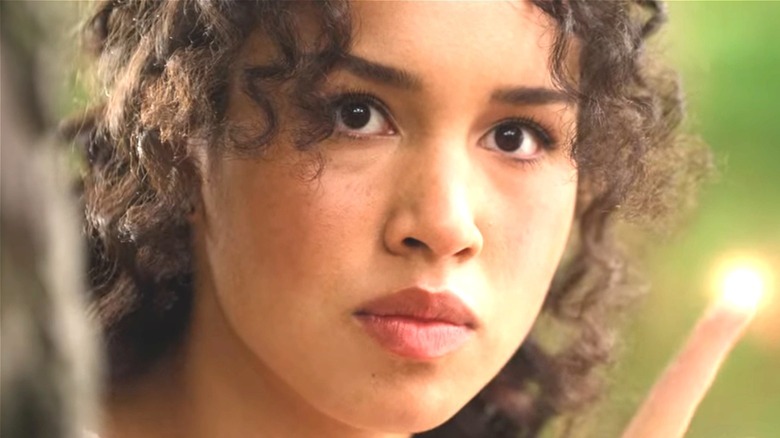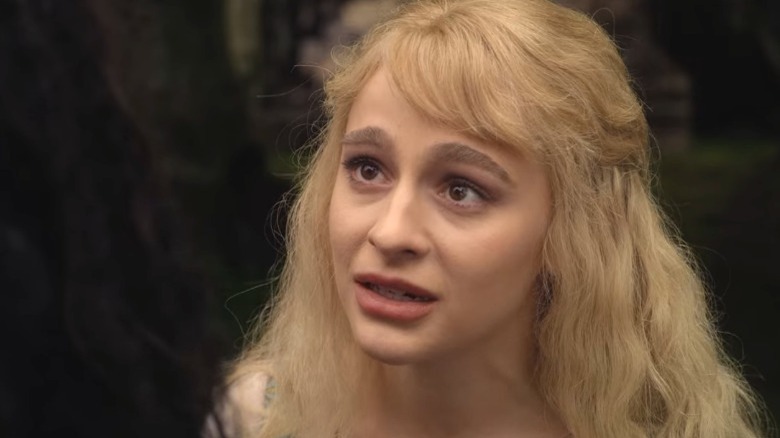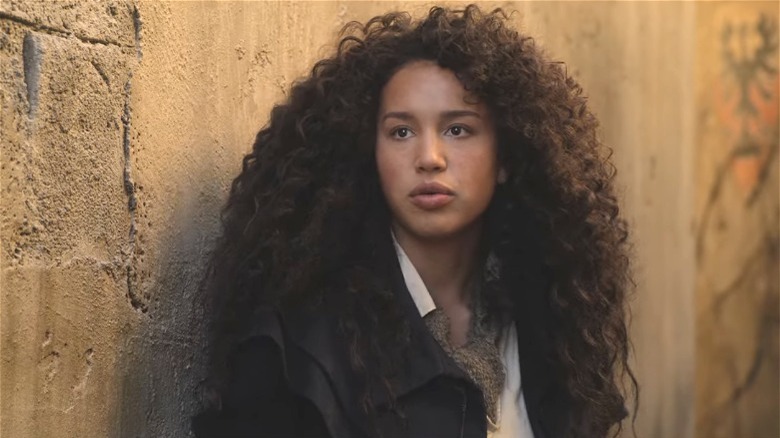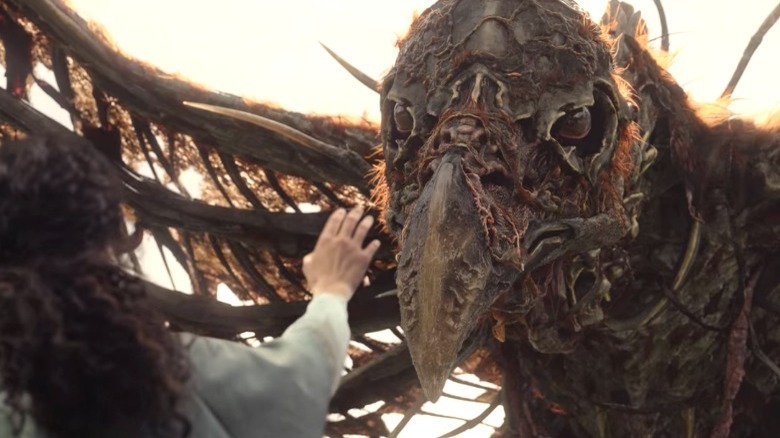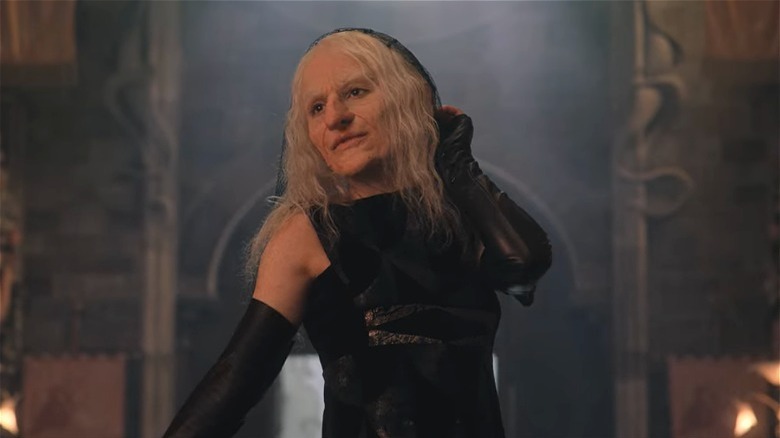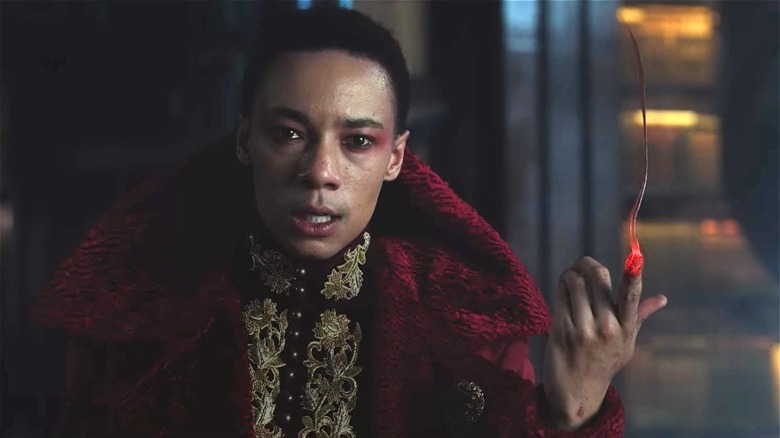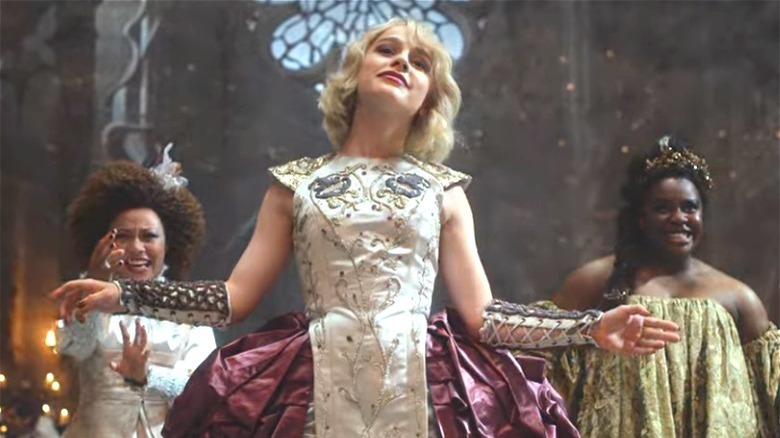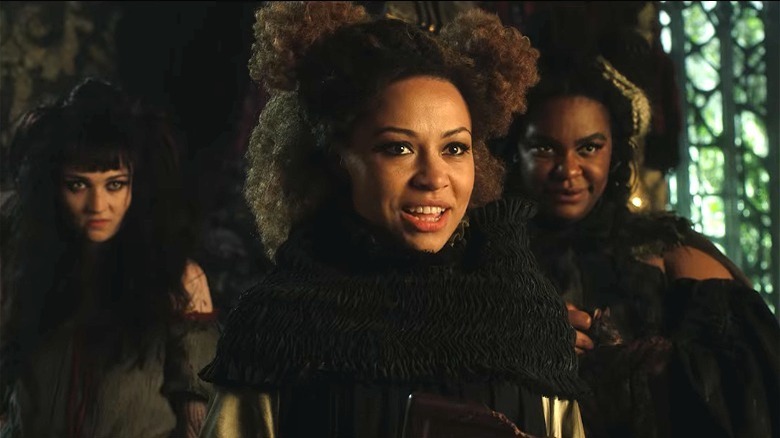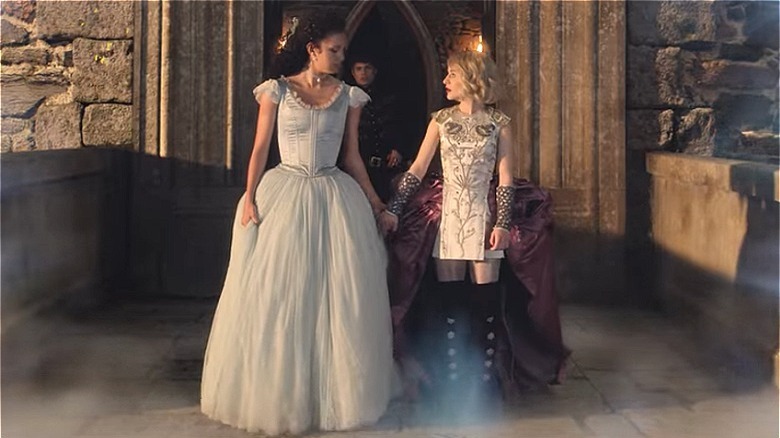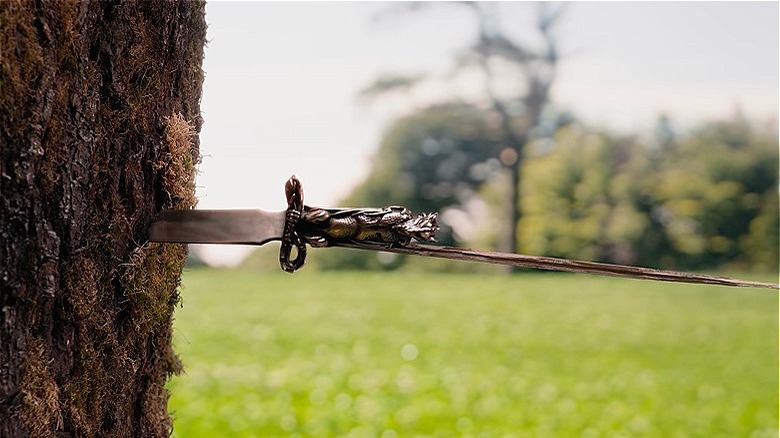The Ending Of The School For Good And Evil Explained
Once upon a time, there were two best friends who became each other's worst enemies. Would they destroy one another, or would they fight to restore their friendship once more?
The Netflix movie "The School for Good and Evil" is an adaptation of the first book in the young adult fantasy series by Soman Chainani. With six novels in all, the series follows the story of Sophie and Agatha, two best friends who are swept away into a magical world of fairy tales. In this world, fairy tale heroes are trained at the School for Good, and fairy tale villains at the School for Evil. The book "The School for Good and Evil" received positive reviews from critics (per Goodreads), and the series as a whole has sold over 3.5 million books worldwide. Directed by Paul Feig, the movie stars Sofia Wylie as Agatha and Sophia Anne Caruso as Sophie. It also features big stars like Kerry Washington, Charlize Theron, and Laurence Fishburne.
During their adventures at the School for Good and Evil, Agatha and Sophie learn that the fairy tales they thought they knew so well are nothing like what they expected. It turns out that dark things are afoot on both sides, and it's up to them to set things right. But what lessons will they learn along the way? Can there ever be true balance when Good always seems to win? We'll try to tackle these questions and more as we explain the ending of "The School for Good and Evil."
Sophie's choices
Like many young girls, Sophie dreams of being the princess of her very own fairy tale. Just like Cinderella, she longs to escape her dull life in the village of Gavaldon and become the extraordinary person she was always meant to be. After Sophie makes a wish that takes her and Agatha to the School for Good and Evil, it seems that all of her dreams are about to come true. What she discovers is that being in a true fairy tale world is nothing like what she had hoped for.
Although Sophie believes that her pretty hair and her affinity for nice things make her the perfect candidate for the School of Good, her actions speak otherwise. She breaks her promise to Agatha not to leave Gavaldon, she's dishonest with the boy she insists is her true love, and she completely disregards Agatha's feelings about wanting to return home. Though she claims to be good, time and time again Sophie proves that the only person she cares about is herself — an innately evil trait.
It isn't until the end of "The School for Good and Evil" that Sophie realizes the destruction that her choices have wrought. Her need to feel special has caused pain to everyone around her and allowed her to be easily manipulated by Rafal. However, she finally comes to understand that being special means nothing if it means losing the ones you care about. Casting her own selfish wants aside, Sophie makes the ultimate sacrifice to save her best friend's life, even if it means losing her own. In the end, Sophie returns to Gavaldon a little bit humbler and a little bit wiser.
Agatha becomes the reluctant hero
For the majority of her life, Agatha has been an outcast. Thanks to her mother's affinity for brewing potions (that don't actually work), the villagers of Gavaldon call Agatha a witch and bully her incessantly. It doesn't help that she wears drab clothes and doesn't follow societal norms. Her only comfort has been her best friend, Sophie, who has always had her back and shown her kindness. But when Sophie says that she is leaving Gavaldon forever, Agatha fears being alone once more. Desperate to hold onto her only friend, Agatha travels with Sophie to the land of fairy tales and the School for Good and Evil.
Much to her shock, Agatha has been placed in the Good school instead of Sophie, who somehow ended up on the Evil side. Being forced to wear fancy ball gowns and act pretty and polite is not Agatha's idea of paradise, and all she wants is to find Sophie so they can both go home. Yet as Sophie succumbs to the evil inside her, Agatha knows that her friend has to be saved –- and she's the only one who can do it.
After years of Sophie coming to Agatha's rescue, now it's Agatha's turn to rescue Sophie. All Agatha has ever wanted was an ordinary life, but her ability to empathize with others and her willingness to stand against oppression make her an extraordinary person. In the end, Agatha finds the hero within herself to help her friend and save the whole school. She also learns to embrace her uniqueness rather than be ashamed of it.
Something's rotten in the School of Good
From the moment Agatha arrives at the Good school, it's clear that things are not what they seem. She encounters angelic fairies with razor-sharp teeth and hostile dispositions, a beauty class that fails students for not smiling prettily enough, and mean girl princesses who would put Regina George to shame. It quickly becomes apparent that the School of Good is not so much interested in being good, but in appearing good.
A conversation between Dean Dovey (Washington) of the Good side and Dean Lesso (Theron) of the Evil side reveals that even they have their suspicions of things not being quite right at the school. Though it's stated that the School Master (Fishburne) doesn't make mistakes, it's also inferred that questioning him can lead to terrible consequences. Luckily, Agatha isn't afraid to stand up and fight against the injustices she witnesses within the school.
If there's one thing that "The School for Good and Evil" tries to get across, it's that authority should be questioned –- and, if need be, challenged. Even the most well-meaning authority figures are not infallible and in the case of "The School for Good and Evil," many of them can be hiding secret corruption. As Agatha and the other students learn, things won't change unless someone steps forward to change them.
Beauty is as beauty does
Once Sophie accepts her role as a witch, she becomes the queen bee of the Evil school. Trading her long locks and affinity for fancy gowns for a stylish bob and fashionable black attire, Sophie appears to be in her element. Even Tedros (Jamie Flatters), the handsome and popular prince from the Good School, can't seem to resist her charms.
Even with her rise in social status and newfound confidence, Sophie is still determined to prove that she belongs in the Good school. Yet as Rafal's (Kit Young) influence keeps its hold on her, she finally gives in to her darkest impulses, and he gifts Sophie with the power of forbidden blood magic. That's when Sophie's transformation from light to dark begins to show physically, and in a terrifying way.
Starting with a dark mole on her cheek, Sophie's good looks begin to alter into that of a fairy tale hag. She gets a long hooked nose, deep wrinkles, and thin white hair. Instead of being horrified by the change, Sophie embraces it as her magical power grows. But it's more than just Rafal's dark power that's initiated the transformation. As Sophie's actions become increasingly evil, the darkness of her heart manifests as a grotesque appearance. Where once she was young and beautiful like a princess, her looks change to mirror what she has become on the inside -– a wicked witch.
Why Rafal's plan worked so well
In "The School for Good and Evil," the students on each side have nicknames. On the Good side, students are called Evers because they always live happily ever after. The students from the Bad side are called Nevers, because ... well, you get it.
In the movie's prologue, it is explained that brothers Rhian and Rafal (both played by Young) are responsible for maintaining the balance of good and evil. Yet if good always wins and evil always loses, how can they be even? This is explained in the film's third act when the evil Rafal reveals that he killed his brother, Rhian, thus tipping the balance in evil's favor. Disguising himself as the School Master -– who everyone assumed was Rhian -– Rafal was able to take over the school without anyone ever noticing that anything was amiss.
So why did no one ever question why good always has the upper hand after all these years? Being the epitome of evil, Rafal is a master of deception and manipulation. Most are quick to believe that good will always triumph over evil — which is what made it so easy for Rafal to fool everyone. Meanwhile, the School of Good was happy to feed their own egos rather than believe that something was wrong. As a result, they lost their ability to see beyond their own shallow desires, which made it easy for them to become weak and for Rafal to enact his scheme. Luckily, Agatha and Sophie arrived at the school just in time to upend the status quo and restore the balance once more.
Good and evil are not so black and white
From the beginning of time, fairy tales have been designed to thrill young children as well as entertain them. Most importantly, they're meant to teach morals, and prove that being good will always win the day. However, real life is not so simple, and "The School for Good and Evil" demonstrates that even in the land of fairy tales, good and evil are not always what they appear to be -– in some cases, literally.
Throughout "The School for Good and Evil," we see the villains dressed in black and the heroes dressed in bright, pleasant colors. In the movie's climax, an intense battle breaks out between the Evil students and the Good. Sophie uses her magic to transform the Evil students' clothing into white and the Good students' black, in a symbolic gesture that suggests their roles have changed. As the heroes and villains clash, it almost becomes impossible to tell who is who. The metaphor is clear, demonstrating that anyone can be good or evil, and many people are both.
Earlier in the movie, when Dean Dovey asks Agatha if she believes that Sophie is truly good, Agatha responds, "I don't believe anyone is truly good or truly evil, because people are complicated." In stating one of the biggest themes of "The School for Good and Evil," Agatha hits the nail right on the head. At the movie's conclusion, this revelation suggests a big change for the future of the School for Good and Evil.
The danger of labels
Anyone who's survived high school knows how harmful labels can be. Whether it's "Nerd," "Jock," "Band Geek," or any iteration thereof, these epithets can be used either to degrade or to elevate a person's status. They can also be used as a way for young people to define themselves on their way to discovering their personal identities, which is an important stepping stone in growing up.
Now imagine what it would be like to grow up with the idea of either being "Good" or "Evil" pounded into your brain. What kind of damage would that cause? What would that do to a young person's ego? In "The School for Good and Evil," Sophie's motivation comes from her mother's dying words that she is special and destined for great things. While this was meant to give her daughter hope, Sophie took the words to heart. She truly believes that she was meant to become a princess, like in her favorite fairy tale. When that dream is destroyed, she goes to extreme lengths to gain the power that she believes she deserves and has been denied.
In a similar fashion, the students at both the Good and Evil Schools are trained to be the best heroes or villains they can be. Many of them are placed at the school based on their bloodlines, such as Tedros, who is the son of King Arthur, and Hestor (Freya Parks), the daughter of a hag. Because they have been led to believe that they are who they are because of where they come from, they don't realize that they have a choice. It isn't until Agatha saves the day that the students come together as allies instead of enemies, and are free to decide for themselves who they want to be.
Real love is found in friendship
Unfortunately, fairy tales have skewed many of our views on the definition of true love. In most stories, it is presented as romantic love. However, as we've come to learn, true love comes in many forms –- and besides, romance isn't everyone's cup of tea. When Sophie and Agatha go to the School Master to try and straighten things out in "The School for Good and Evil," the School Master offers them a chance to prove once and for all that Sophie belongs on the Good side. Of course, the one sure way to tell for certain if someone is on the side of good is for them to have true love's kiss.
Sophie believes this to be an easy task, as she already has her eye on the handsome Prince Tedros. Of course, things are a bit more complicated than that. Besides the fact that Tedros is already dating Beatrix (Holly Sturton) from the Good side, it turns out that the attraction between Sophie and Tedros is just superficial.
At the end of "The School for Good and Evil," true love's kiss comes in a form that is unexpected. As Sophie lay dying in Agatha's arms, Agatha places a kiss on Sophie's lips. It isn't a romantic gesture, but rather a kiss from her best friend whom she dearly loves. The kiss brings Sophie back to life, and the two friends are reunited once more.
Happily never after?
Every fairy tale ends the same way: "They lived happily ever after." At least, that's what we've been led to believe. But does a story ever truly end? After Sophie and Agatha return to Gavaldon, it seems things are back to normal for the two young women. However, in the movie's final scene, we see the portal between Gavaldon and the land of fairy tales open, and an arrow shoots through and strikes a tree. A dagger with a hilt in the shape of a dragon follows, splitting the arrow in two. According to the Storian (voiced by Cate Blanchett), the arrow belongs to Tedros, who calls out for Agatha's help.
This ending is likely setting up a potential sequel to Netflix's "The School for Good and Evil." If that's the case, it would probably follow the plot to Chainani's second book in the series, "A World Without Princes." In the book, Agatha and Sophie return to the school to find that the girls and boys have been separated, with all the girls now on the Good side, and all the boys on the Evil side. It's up to Sophie and Agatha to figure out what's gone wrong at the school and try to fix it.
Whether or not we'll see another Netflix movie set in Chainani's fantasy world is uncertain, though the author hopes that will be the case. General audiences seem to have a fondness for "The School for Good and Evil," but it hasn't exactly impressed critics (via Rotten Tomatoes). However, the biggest influence on Netflix's decision to greenlight the sequel will probably be viewing numbers. If enough people watch "The School for Good and Evil" on the streaming platform, we might just see "The School for Good and Evil 2" in the future.
